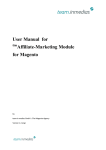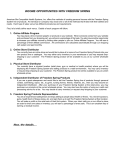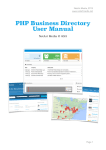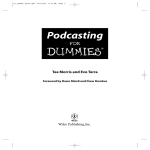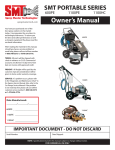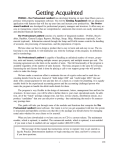Download The ABC`s of Ecommerce and Dropshipping Success
Transcript
The ABC’s of Ecommerce and Dropshipping Success Practical guide how to start and run a successful online store and ecommerce business Robert H. Froyk www.abc-of-ecommerce.com Pages ii and iii are not shown in this free preview. To see them, please buy the full ebook from www.abc-of-ecommerce.com Contents List of tables........................................................................................................................................... v Preface..................................................................................................................................................vi Chapter 1. Ecommerce and dropshipping basics..................................................................................1 Chapter 2. Creating your online store...................................................................................................4 Selling products on your own website................................................................................. 4 Selling products through online marketplaces..................................................................... 5 Chapter 3. Getting traffic to your online store......................................................................................8 Paid traffic........................................................................................................................... 8 Free traffic........................................................................................................................... 9 Chapter 4. Search engine optimization for your online store..............................................................19 On-Page SEO.....................................................................................................................19 Off-Page SEO.................................................................................................................... 21 Backlink sources................................................................................................................23 Chapter 5. Customer service and satisfaction level.............................................................................27 Chapter 6. Tips and advices to increase the conversion rate of your online store and to get more sales....................................................................................................................................30 Chapter 7. Practical example: Selling on an online marketplace using the dropshipping business model................................................................................................................................. 34 Chapter 8. Practical example: Selling on your own website using the dropshipping business model................................................................................................................................. 48 Final thoughts......................................................................................................................................58 Glossary................................................................................................................................................60 Index.....................................................................................................................................................66 iv List of Tables Table 1. Popular shopping cart software................................................................................................4 Table 2. Popular online marketplaces....................................................................................................6 Table 3. Online advertising networks....................................................................................................8 Table 4. Popular price comparison websites........................................................................................10 Table 5. Online classified ads websites................................................................................................12 Table 6. Question and Answers websites.............................................................................................14 Table 7. Rating and review websites....................................................................................................17 Table 8. Photo sharing and image hosting websites.............................................................................18 v Preface Internet is developing with high paces. As of 2011, there were 2.26 billion Internet users worldwide, or 32.7% of total world population. Apart from communication, information, socializing, entertainment, education, etc., many of these users use the Internet for shopping. More and more Internet users choose to buy online rather than from the regular retail stores. In 2011, the global ecommerce market was estimated to be worth around $680 billion, with a 19% increase from the previous year. And in the years to come, these numbers will only grow. With such a high potential, many entrepreneurs and businesses started exploring and getting into the ecommerce business; and they should. Ecommerce is an opportunity not to be overlooked. In this ebook, we will take a closer look into the ecommerce world and will show you how to create and run a successful online store and ecommerce business. We will focus more on the practical side and less on the theory. Along with the old techniques, we will show you some of the newest techniques and how-to’s from the ecommerce and marketing field. We will cover all the processes involved in ecommerce, starting from creating an online store, getting traffic to it, optimizing it for the search engines and finishing with customer service and tips for increasing sales and conversion rate. Many links to external resources will be given in every of the eight chapters that this ebook has, for further reading and learning. This ebook is good for people who have a traditional retail store and want to start selling online, it is good for people who do not have anything and want to sell online, and it is good for established ecommerce businesses and online stores, who may learn something new and expand their knowledge. Chapter 1 provides a short overview of the ecommerce and dropshipping concept. There we will show you the basic concept of ecommerce and dropshipping. Links to external resources will be given in this chapter for further reading and learning so that you could better understand what ecommerce and what dropshipping is. Chapter 2 presents all the information needed for creating an online store. In that chapter we will talk about how to create an online store and will present you a list with some of the most popular online marketplaces and shopping cart software. Chapter 3 is all about traffic. There we will talk about different ways of getting traffic to your online store, both free and paid methods, and will review some of the best sources of free traffic. Chapter 4 is dedicated to search engine optimization. In that chapter we will analyze the different factors that influence the search engine rankings of your online store. We will analyze both the internal factors (on-page SEO) and external factors (off-page SEO) and will show you some good backlink sources for your online store. Chapter 5 is about customer service and shows some ways in which you should treat your customers and what you need to do in order to have satisfied customers and a good reputation of your online store. vi Preface Chapter 6 explores the methods and techniques used to increase sales. There you will read some tips and advices on how to increase the conversion rate and sales of your online store. And finally, chapter 7 and 8 is dedicated to two practical examples of creating an online store. There you will see in practice how to create and run an online store on an online marketplace and on your own website, using the dropshipping business model. vii Pages 1 to 5 are not shown in this free preview. To see them, please buy the full ebook from www.abc-of-ecommerce.com Chapter 2: Creating your online store Table 2. Popular online marketplaces General marketplaces Name URL eBay http://www.ebay.com Amazon http://www.amazon.com/ eCrater http://www.ecrater.com eBid http://ebid.net/ uBid Webstore.com Atomic Mall Boocoo Auctions Blujay http://www.ubid.com/ http://www.webstore.com/ http://www.atomicmall.com/ http://www.boocoo.com/ http://www.blujay.com/ OnlineAuction SpecialistAuctions WeBidz ePier Plunderhere CQout Usiff Wensy Taobao http://www.onlineauction.com/ http://specialistauctions.com/ http://www.webidz.com/ http://www.epier.com http://www.plunderhere.com/ http://www.cqout.com/ http://usiff.com/ http://wensy.com/ http://www.taobao.com/ Tmall http://www.tmall.com Yahoo Auctions Japan Bidders Molotok 24au.ru http://auctions.yahoo.co.jp http://www.bidders.co.jp/ http://www.molotok.ru/ http://www.24au.ru/ Notes Generates a lot of sales and profit but some sellers complain about their high fees. Popular worldwide. Just like eBay, generates high sales and profit but sellers complain about high fees. 100% free marketplace. You do not have to pay any fees on this marketplace. Design is nice and clean. Professional marketplace but some sellers complain about the low volume of sales. Same as eBid. No buying or selling fees, No signup fees 100% free online marketplace but has very low traffic so you will have to do a lot of promotion. It is available only in Chinese language. If you know Chinese, you may sell on this marketplace. As of March 2012, it is ranked the 14th most popular website on the internet by alexa.com. For comparison, eBay is ranked 21st most popular in the world by the same website. You may hire a Chinesespeaking person to sell on this marketplace. Owned by Taobao. If you know Chinese you may sell on this marketplace, or you may hire a Chinese-speaking person to sell there. Very popular in Japan. You may hire a Japanese-speaking person to sell there. Popular in Japan. Very popular in Russia. Popular in Russia. 6 Page 7 is not shown in this free preview. To see it, please buy the full ebook from www.abc-of-ecommerce.com Chapter 3 Getting traffic to your online store Now that we have the products to sell and a place where to sell them, it’s time to bring some potential buyers to our store, or in other words, “traffic”. Web traffic is the total amount of visitors a website or online store receives in a period of time. For an ecommerce business, traffic is vital. Without it, you have no sales; this is why every ecommerce business should focus on receiving more traffic. More traffic means more potential buyers and thus more sales. Traffic is like gasoline for cars; without it, your ecommerce business will not work. In terms of money spent, there are two types of traffic: paid traffic and free traffic. Paid traffic is a good source of potential buyers if it is done correctly, but I think that online stores should focus more on the free traffic because it is free, usually its effects last longer than the paid traffic, and it is very abundant (if you know where and how to get it). Paid traffic is for fast results on short term while free traffic is for slow results, but on long term. Paid traffic Paid traffic may be used when the online store is new and does not have sales and/or reputation, or when there are some ongoing promotions or discounts available, but in the long term, it is better to focus on the free traffic. Paid traffic can be classified in CPM advertising (Cost per Mille or Thousand Views), PPC advertising (Pay per click, also called Cost per Click), CPA advertising (Cost per Acquisition or Action) or in fixed cost for some banner advertising. Depending on what type of advertising model you choose, your ad may show on other websites, on search engine results pages, on emails, videos, various online groups, etc. Some good online advertising networks are listed below, in Table 3. Table 3. Online advertising networks Name Google AdWords Chitika Bidvertiser AdBrite Facebook Advertising Yahoo! Advertising Microsoft Advertising Baidu Phoenix Next (for Chinese market) Yandex.Direct (for Russian and CIS market) Casale Media Zanox (for German, Italian and European market) ValueClick Media Burst Media URL http://www.google.com/adwords http://chitika.com/ http://www.bidvertiser.com http://www.adbrite.com/ http://www.facebook.com/advertising/ http://searchmarketing.yahoo.com/ http://advertising.microsoft.com/ http://e.baidu.com/pro/ http://direct.yandex.com/ http://www.casalemedia.com http://www.zanox.com/en/ http://www.valueclickmedia.com/ http://www.burstmedia.com/ 8 Chapter 3: Getting traffic to your online store CPX Interactive Mail.Ru Advertising (for Russian and CIS market) Tribal Fusion Text Link Ads AdChina (for Chinese market) Ad Magnet (for Indian market) Blogads ExoClick Hi-media (for French and European market) Kontera Hi-Mídia (for Brazilian market) Adknowledge Advertising.com Ikoo (for Arabian market) D.A.Consortium (for Japanese market) Clickbooth http://www.cpxinteractive.com/ http://corp.mail.ru/adv/ http://www.tribalfusion.com/ http://www.text-link-ads.com/ http://www.adchina.com/ http://www.admagnet.com/ http://web.blogads.com/ http://www.exoclick.com/ http://www.hi-media.com/ http://www.kontera.com http://www.hi-midia.com/ http://www.adknowledge.com/ http://www.advertising.com/ http://www.ikoo.com/ http://www.dac.co.jp/ http://www.clickbooth.com/ Free traffic Free traffic is a good source of potential buyers to your store. If done correctly, this can be a stable long-term traffic source. This is why it is imperative that online store owners focus more on the free traffic rather than on the paid one. Paid traffic is also good – it brings fast results; but as fast as it comes, as fast it goes. On the other hand, free traffic brings slow results in the beginning, but in the long term, it brings much more traffic and profit than the paid one. So let us review some of the best free traffic sources for an online store. 1. Search Engines – Clearly, search engines are the best source of free traffic for any website, including online stores. However, in order to receive high amounts of stable and targeted traffic from the search engines, there is some work that needs to be done and to be more precise – SEO or Search Engine Optimization. More about SEO we will talk in the next chapter. If you have a standalone online store on your own website, then it would be beneficial if you would create a sitemap of your online store and submit it to all major search engines like Google, Bing, Yahoo (for English speaking and most international market), Baidu (for Chinese market), Yandex, Mail.Ru, Rambler (for Russian and former USSR market), Naver, Daum (for South Korean market), etc. You may submit the URL of your homepage and sitemap to each search engine manually, or you may use a free search engine submitter (e.g. SubmitExpress) that will submit your online store URL automatically to all search engines. 2. Video Marketing – Video marketing refers to the process of promoting your products or services using videos. You just create a video and upload it to a popular video hosting website. You get traffic from these videos by putting the URL of your online store in the beginning and the end or in the right or left corner of the video. You may also put a link to a specific product from your store in the description of the video. 9 Chapter 3: Getting traffic to your online store Video marketing is a very good source of targeted traffic. An old saying states that a picture is worth a thousand words, but in the case of video… it’s worth a lot more. For instance, if you create a video of your product, and you get 10.000 views (which is not that hard if you use right title and tags), you get 10.000 potential buyers for that product, so this is a method worth trying. To get the maximum out of this method, it would be good to create videos with all the products you sell. However, if you have thousands of products, then creating videos of the most popular ones will be enough to get some good traffic to your store. You may film the product without saying anything, or you may film it while commenting in the background of the video. If your ecommerce business is based on dropshipping and you do not have the products physically, then you can create a short video using the photos of the products. A good service that you can use for this is onetruemedia.com. You just upload your photos on that website, add a soundtrack from the sample list and the video is ready. It will be like a small 45 seconds presentation video. After this, you upload the video to some video hosting websites and enjoy the traffic. Probably the best video hosting website is Youtube, so you should focus more on it. To get more views of your videos, don’t forget to put your keywords and product name in the title, description, and in the tags of the videos. The thumbnail of the video has a big influence on the number of views so try to choose the best thumbnail. This way you will get more views on Youtube. You may also submit your videos to other websites like Metacafe, Vimeo, Dailymotion, etc., but don’t expect to receive much traffic from them. In my opinion, for video marketing, Youtube is the best. A good list of video hosting websites where you can submit your videos, is available at http://en.wikipedia.org/wiki/Comparison_of_video_hosting_services. 3. Price Comparison Websites – These websites are gold mines for online stores. They are used by millions of people and bring huge traffic to the online stores listed in them so it is imperative that you do you’re best to list your store into these price comparison services. Price comparison websites can bring even more traffic than the search engines or video marketing. In order to get your store listed, you must create a feed of the products you sell, usually in the .xml or .txt format, and submit that feed to the price comparison websites where you want your products to appear. Some of the shopping cart software we discussed in the second chapter allow to generate this feed automatically for some price comparison websites. There are paid and free price comparison services. Some marketplaces submit your product data feed automatically to the most popular free price comparison websites. Almost all price comparison services require registration, which is usually free. Below is a list with some of the most widely used price comparison websites. Table 4. Popular price comparison websites Name URL Google Product http://www.google.com/shoppi ng Bing Shopping http://www.bing.com/shopping TheFind http://www.thefind.com/ Data Feed information and specification http://support.google.com/merchants/ bin/answer.py?hl=en&answer=18849 4#other http://advertising.microsoft.com/smal l-business/search-advertising/bingshopping http://merchantblog.thefind.com/2011 /01/merchantnewsletter/demystifying-product- Cost Free Free Free 10 Pages 11 to 13 are not shown in this free preview. To see them, please buy the full ebook from www.abc-of-ecommerce.com Chapter 3: Getting traffic to your online store Slando Iz ruk v ruki Classifieds Giant http://www.slando.ru/ http://irr.ru/ http://classifiedsgiant.com/ Very popular in Russia and CIS. Popular in Russia. Popular in Russia, Estonia, Ukraine, Kazakhstan, Belarus and Uzbekistan. 6. Question and Answers websites – Q&A websites can be a good long-term traffic source. You get traffic by answering questions related to the products you sell, and specify your online store as the source. This is a very effective method of getting targeted traffic, and potential buyers to your online store. Since your answers will be visible on the Internet for years, these websites are considered longterm traffic source. It is good to note that self-promotion is penalized very hard on these websites, so try to answer only to questions related to the products you sell and try to format the answer in a helpful way, rather than as an advertisement of your store or products. Do not spam on this websites and use them accordingly to their terms of service. Some good Q&A websites are listed in the table below. Table 6. Question and Answers websites Name Yahoo Answers URL http://answers.yahoo.com/ Quora http://www.quora.com/ LinkedIn Answers Ask Reddit SocialAnswers Answers.com Rediff Q&A Formspring Ask MetaFilter Google Baraza Q&A Amazon Askville Answerbag ChaCha Stack Exchange Network http://www.linkedin.com/answers http://www.reddit.com/r/AskReddit/ http://www.socialanswers.com/ http://www.answers.com/ http://qna.rediff.com/ Popular in India http://www.formspring.me/ Social Q&A website http://ask.metafilter.com/ http://www.google.com/baraza/en/ http://askville.amazon.com/ http://www.answerbag.com/ http://www.chacha.com/ http://stackexchange.com/ Has many sub sites classified by topic. http://www.blurtit.com/ http://www.allexperts.com/ http://aolanswers.com/ http://www.askmehelpdesk.com/ http://www.webanswers.com/ http://www.fluther.com/ http://www.askpedia.com/ Blurtit Allexperts AOL Answers Ask Me Help Desk WebAnswers Fluther Askpedia Note One of the most popular Q&A website, which also brings a lot of traffic. Popular worldwide. Has a very intelligent community. It is intermediate between an expert Q&A website and a general public Q&A website. 14 Pages 15 to 18 are not shown in this free preview. To see them, please buy the full ebook from www.abc-of-ecommerce.com Chapter 4 Search engine optimization for your online store Search engine optimization (SEO) is the process of improving the rankings of a website or webpage in the “organic” or “natural” search results of a search engine. Usually, the higher the rankings of a website or webpage are in the search engine results page, the more visitors it receives from the search engine's users. This is why SEO is so important if you want to get high amounts of traffic for specific keywords or search terms. With the help of SEO, your online store or product pages can get higher rankings in the search engine results page, thus getting more visitors from the search engine’s users. Search engine optimization can be divided into two big categories: On-Page SEO and Off-Page SEO. On-page SEO focuses on optimizing the internal ranking factors of a website or webpage, which affects its position in the search engine results, while the off-page SEO focuses on optimizing the external factors. Optimization can be done for a specific search engine (e.g. Yahoo) or can be done for all search engines, like using a universal method. In this ebook we will focus more on how to optimize an online store for the majority of modern search engines. On-Page Search Engine Optimization On-Page SEO consists of optimizing the internal pages of your online store, in order for them to be more search engine friendly and to receive better placement in search engine results page. On-Page SEO needs to be done to increase the relevance of the webpage in the eyes of a search engine. This can be done by optimizing the internal ranking factors of a webpage. If you use an online marketplace to sell your products, then your possibilities for doing on-page optimization may be somehow limited, but this does not mean that you can not optimize your online store from that marketplace. On the other hand, if you have your own online store, you may implement all of the methods and advices presented below. Some of the shopping cart software are SEO friendly by default while some aren’t, so you need to keep this in mind when choosing the shopping cart software for your online store. In the list below, we will try to examine some of the most important internal ranking factors. Title tag – Title tag displays the title of a webpage so it is highly recommended to include in it the keywords for which you want to optimize the webpage. The title should be 20 – 50 characters long. Try not to write very long titles since they dilute the keywords and weaken their SEO impact. It is not advisable to use special characters in the title tag. It is also important to write unique titles. Description and keywords meta tags – They are not very important but it still isn’t bad to add some of your keywords in the description and in the keyword meta tags. It is also advisable the description and the keywords to be unique. Webpage URL – It is wise to add some of your keywords in the URL of the page you want to optimize. It would also be beneficial to have not too long URLs, and to place the words and keywords between dashes (e.g. yourwebsite.com/products/tv/24-inch-plasma-tv-with-remotecontrol.html). 19 Page 20 is not shown in this free preview. To see it, please buy the full ebook from www.abc-of-ecommerce.com Chapter 4: Search engine optimization for your online store Ads to content ratio – Some webmasters claim that too many ads on a low content page may be harmful for your search engines results ranking. In my opinion, there should be no ads on an online store, since they can send away your potential buyers to some other websites and you may end up with fewer sales. These were some of the most important on-page search engine ranking factors. Some of the webmasters argue that many of the on-page ranking factors are not relevant any more for getting high rankings in the search engines, and website owners should focus more on the off-page SEO. While this may be true to some extent, doing on-page SEO does not hurt your rankings, so it is still advisable to do it, since your online store will only benefit from it. As a common saying in the webmasters world: On-page SEO is to show the search engine that your page is relevant (for some keywords), while the off-page SEO is to show that the website/webpage is popular. As an advice, we recommend not to optimize the web pages for multiple keywords, but rather to optimize them for fewer keywords, preferably for those that have less competition, and to use only unique content on pages. Now that we have analyzed the on-page ranking factors and know how to optimize our online store internally, it is time to move to the next step and see how to optimize our online store using off-page SEO, which compared to the on-page SEO, has a much more weight and value for the search engine rankings. Off-Page Search Engine Optimization Off-page SEO is the combination of techniques and methods used outside of your online store, in order to help it and its web pages to get higher rankings in the search engines. Off-page SEO includes optimization of factors that are not located on your online store. These factors include: Number of authority backlinks – Authority backlinks are links from websites and web pages with relevant content and high rankings in the search engines. If you want to get high rankings in the search engines, then having many authority backlinks is a must. These links sometimes are also called “quality backlinks”. Anchor text of the backlink – This is a very important ranking factor for the particular keyword you try to rank. Try to use different keywords as your anchor text since having the same keyword on many backlink anchor text may be penalized by the search engines, so it is good to diversify a little bit. As an anchor text, try to use the keywords that you have used when doing on-page optimization. This will give the best results. Keyword density and relevance – Backlinks from relevant pages, with an average (2-4%) keyword density, are the best if you want to have high rankings in the search engines. It is also good for the keyword to be in the title of the page linking to you. On the other hand, if the keyword density of the webpage you get a backlink is very high, then the search engines may penalize that webpage and reduce its authority and trustiness, so you will end up having a low quality backlink from a low quality page, which is not desirably. Backlink diversity – It is best to have links from lots of different domains since having links only from few domains may look suspicious to the search engines and they could lower your rankings. Having backlinks from many different domains shows the search engine that your online store and its 21 Page 22 is not shown in this free preview. To see it, please buy the full ebook from www.abc-of-ecommerce.com Chapter 4: Search engine optimization for your online store then your online store will rank high in United Kingdom, or, if you have many backlinks from .fr websites, then your online store will rank high in France, and so on. This also applies to the topic of the websites from where you get backlinks. For example if you have many backlinks from websites about coins, then your online store will rank high for coins related keywords. These were some of the most important off-page ranking factors. Optimizing all of these factors confers your online store a higher authority, which in return leads to higher rankings in the search engines and more targeted traffic from them. Backlink sources As you have seen in the list above, many of the off-page ranking factors focus on backlinks. Backlinks pointing to your online store may be viewed as votes. So the more votes your website or webpage has, the higher it will rank in the search engines. It is also important from where those links (votes) come from, since some backlinks have more weight or value than other do. Some backlinks may even be bad for your online store rankings, like receiving a negative vote. So as you can see, the source of your backlinks is very important for your online store rankings in the search engine, this is why it is recommended to get backlinks only from the best sources. Some good sources of backlinks are presented in the list below: Article Websites – Article websites, or sometimes called article directories, are one of the best source of high quality backlinks. To obtain the best results, the keywords for which you try to optimize must be used in the title of the article and as the anchor text in the backlinks to your online store. The keyword density of the article should not be more than 2-3%. It is important to write the articles in a helpful, informative way, so that the readers would not see it as an advertisement of your online store, but rather to see it as a help. It is also good to use images in articles. Submitting the same article to different article websites is not advisable. Some good article websites where you can submit your articles were presented in the previous chapter (see page 15). Press Releases – Press releases, just like articles, are a very good source of high quality backlinks. All of the writing and optimization advices for articles can, and should be applied for press releases. A good list of websites to submit your press releases is shown in the previous chapter (see page 17). Blog commenting – Blog commenting is a useful and very popular method of getting many backlinks from a single domain. It is important to get backlinks from blogs and posts with related content. Getting backlinks from blogs with unrelated content may harm the rankings of your online store for the keywords you try to optimize. To find blogs with the “Top commentator” plugin and with related content you may do a google search with your keyword in the query and the phrase “Top commentators”. For example, the Computer “Top commentators” search query will find blog posts that contain the word “Computer” and have the “Top commentators” plugin installed. Another good way to find blogs with related content where you can comment is using special blog search services like http://www.inlineseo.com/dofollowdiver/ or http://www.google.com/cse/home?cx=010363265520675485990:xjmxcyokkls. With the help of these services, you can find do-follow blogs with your keywords in their posts. It is also very important not to spam on blogs and to post only useful, on topic comments, since if you do otherwise, many of the blog administrators will delete your comments and you will have no backlinks. 23 Pages 24 to 26 are not shown in this free preview. To see them, please buy the full ebook from www.abc-of-ecommerce.com Chapter 5 Customer service and satisfaction level Customer service is the process of providing services to customers before, during, and after a purchase. Its main goal is to enhance the customer satisfaction level and to make sure that the product or service has met the customer’s expectations. It is one of the major factors in having a successful long-term ecommerce business. You may bring as many new customers as you want, but without the proper customer service, those customers will remain unsatisfied and will not buy from you any more. They may even spread negative information about your online store, leaving you with fewer sales and fewer customers, and all the hard work you have put in promoting your online store and in getting more customers will fade away. On the other hand, if you provide good customer service and meet your customer expectations, then they will come back to buy again from your online store and will share their positive experience with others, which in return will get you even more customers and sales. A company’s most vital assets are its customers, so without them, the company can not exist. When you satisfy your customers, they help you grow not only by continuing to do business with you, but also by recommending you to their friends and associates. It is also important to make your customers not just satisfied, but to make them happy. By doing so, you will get even more sales and more customers and your ecommerce business will flourish. Since the main goal of customer service is to have a high level of customer satisfaction, we will analyze what it takes to achieve this along with the provision of good customer service. So in order to have a good customer service and a high satisfaction level among buyers, the following things needs to be done: Set the right level of expectations – This is probably one of the most important things that needs to be done if you want to get a high level of customer satisfaction. Setting higher expectations will get you more unsatisfied buyers, while setting lower expectations will get you fewer sales, so it is very important to set the right level of expectations for your customers. This can be accomplished by providing an accurate description of your products and by including a product FAQ (frequently asked questions) section in the product page. Provide good technical/customer support –It is essential to make sure that your customers are fully satisfied and are using the products/services according to their uses. Try to include good user manuals, guides, and/or instructions with assistance in installation, training, trouble shooting, maintenance, upgrading, and disposal of the products you sell. Providing a link to the manufacturer’s online user manual is also good if it is available. Surprise your customer – Along with the products that your customers bought, try to include some cheap accessories or products for free. It is also good to include a “thank you” note and a discount coupon inside the package. This way the customers will not be just satisfied, but they will be happy. This will increase the probability that they will buy again from your online store and that they will recommend you to their friends, associates, etc. Deal with all customer complaints – Complains are a major factor in customer satisfaction. There will be times when the products received by the customers may be defective or may have been 27 Pages 28 to 29 are not shown in this free preview. To see them, please buy the full ebook from www.abc-of-ecommerce.com Chapter 6 Tips and advices to increase the conversion rate of your online store and to get more sales While getting many visitors to your online store is important, the rate at which those visits convert into sales is by far more important. An increase in the conversion rate from 1% to 2% is equal to a 100% increase in sales, so this is definitely a point worth focusing and improving. Increasing the conversion rate is a much more viable and effective solution for getting more sales, than trying to bring more traffic. In this chapter we will show you a number of tips and advices on how to increase the conversion rate and the sales of your online store. Therefore, for increasing your conversion rate and sales, feel free to use any of the following advices: Create a sense of urgency for your customers – This is a good marketing technique to get more sales and increase your conversion rate. The theory behind this is that people tend to buy faster and with less thinking when they are rushed by something. So placing a deadline on your product page may increase the sales of that product. Deadlines like “offer available only for x hours and xx minutes” or “only x products left in stock” are very effective. Try to use this tactic only on some of your products because adding deadlines on many products will make the buyers suspicious. Statements like “get this product by next Friday” or “get this product in 3 days” are also good, so if you can ship your products fast, you may add statements like this on your product pages. It is also advised to use a red color background on the deadline phrases. Add a live chat – Live chats significantly increase the sales and the conversion rate. Many customers before buying have many concerns and questions about the product, so a live chat is a very effective way of eliminating those concerns and increasing the sales. The live chat button should be installed on every page of your online store, including on the checkout pages, since many customers drop the sale during the checkout process, so it is very important to have the live chat installed there too. Win customer’s trust – Trust is a major factor when dealing online, especially in the ecommerce field. When a new customer comes to your online store, he has a lack of trust and most of the time will hesitate to buy from you. This is why it is crucial to establish a high level of trust between your online store and your customers. Having a professional looking online store, with good design and professional logo, with an “about us” page, a help page, “contact us” page, privacy policy, a return and shipping policy and a “terms and conditions” page, increases the trust of your online store. It is also very important to add your business address, your phone number and some emails in the “contact us” page. Icons such as PayPal, VeriSign, Visa, Bill Me Later, trust seals, etc., are also very important in gaining customer’s trust. If you are selling on an online marketplace, then your feedback score will probably be the most important factor for your online store trustworthiness. Give detailed answers - When answering customer questions, do not use plain answers like “yes” or “no” but rather give a detailed, friendly answer and always ask in the end if they want to buy that product. 30 Pages 31 to 47 are not shown in this free preview. To see them, please buy the full ebook from www.abc-of-ecommerce.com Chapter 8 Practical example: Selling on your own website using the dropshipping business model Selling on an online marketplace is good, but selling on your own website is even better. It gives you more freedom of action and makes you more independent in the decisions you make, compared to the online marketplace stores. But just like with most things that have a positive side, it also has some negative sides, like a lot of extra work, mainly for promotion, some additional costs for domain and hosting, etc. The steps for selling on your own website are almost the same as to sell on an online marketplace, the only difference being in the third step, which is a little bit more complex. 1. Market research For this example, we will use the market research from the previous example from chapter 7. 2. Finding a supplier We will use the same supplier as in the previous example from chapter 7. 3. Creating the online store This step has the most differences compared to the previous example. For creating an online store on our own website, we need to register a domain name for it, then we need to choose a hosting and to install the shopping cart software that we want to use. Registering the domain name – This is pretty easy. We just go to an online domain registrar and register our domain. When choosing your domain name, make sure it is simple and easy to remember because customers usually do not remember well long domain names. Some good domain name registrars were presented in the second chapter (see page 5). Hosting the online store – Hosting is very important. If we will have many customers, it is wise to use a dedicated hosting service, but for start, a cheap regular hosting or even a free hosting will do. When choosing the hosting, make sure it meets the requirements of the shopping cart software you want to use. A good list with some of the best hosting services can be found at: http://www.webhostingsearch.com/ http://b2evolution.net/web-hosting/top-quality-best-webhosting.php http://www.webhosting.info/webhosts/tophosts/global/ Installing the shopping cart software – For this example we will use the PrestaShop shopping cart software. We choose it because it is free, easy to use and SEO friendly. First thing that we need to do is to download the software from prestashop.com 48 Chapter 8: Selling on your own website using the dropshipping business model Then we need to unzip the .zip folder and copy all of its contains on our web host, either via direct upload or via FTP transfer. After this, we need to create a MySQL database on our web host and to access the “install” folder from our website. If we have copied the prestashop files in the root folder of our website, then the path should look like this: youronlinestore.com/install/ After opening this page, the installation process of the Prestashop shopping cart software will begin. 49 Pages 50 to 57 are not shown in this free preview. To see them, please buy the full ebook from www.abc-of-ecommerce.com Final thoughts Creating and running a successful online store and ecommerce business is not that hard or complex as it seems, but it takes a lot of time. First you need to do a market research to see what products to sell, at what prices, to study your competitors, their weaknesses and strengths, etc. Then you need to create an online store either on an online marketplace or on your own website, then you need to add products to it, optimize it for the search engines, build backlinks, get traffic to it, manage the orders and keep all of your customers happy. The core information needed to do this and to succeed in the ecommerce business is presented in chapter 2, 3, 4, 5 and 6. Chapter 1 was just a small introduction to ecommerce and dropshipping, and chapters 7 and 8 were some basic examples of how to create and run an ecommerce business using the dropshipping business model on an online marketplace and on your own website. I hope you enjoyed reading this ebook and gained some useful information about how to start and run a successful online store and ecommerce business. 58 Page 59 is not shown in this free preview. To see it, please buy the full ebook from www.abc-of-ecommerce.com Glossary Algorithm (search engines) – A step-by-step problem-solving procedure used by the search engines to determine what web pages to suggest for a given search query. Alt attribute – An HTML attribute used for specifying an alternative text of an image. If the browser can’t display images, then the alt text will be displayed instead. The alt attribute also helps search engines and blind people to understand about what an image is. Anchor text – The visible and clickable text of a link. It is very important for SEO. ASP (Active Server Pages) – Server side scripting environment developed by Microsoft. Authority website – A well-trusted website that has high rankings in the search engines and which is cited by many experts from its topical community. B2B (Business to Business) – The exchange of services, information, and/or products between two or more businesses. B2C (Business to Consumer) – The exchange of services, information, and/or products between a business and a consumer. Backlink (Inbound link) – An incoming link to a website or web page. Banner ad – A type of online advertisement in the form of a graphic image. Blog – A periodically updated discussion or information website consisting of a series of entries (posts), which are usually displayed in reverse chronological order so the most recent post appears first. C2C (Consumer to Consumer) – The exchange of services, information, and/or products between two or more consumers. Conversion rate – From an ecommerce perspective, this usually refers to the percentage of visitors to an online store who have bought a product from it. Coupon – A promotional tool in the form of a ticket or document that can be redeemed for a discount or rebate when purchasing products or services. CPA (Cost Per Action) - An online advertising pricing model, where the advertiser pays for a specific action (a purchase, a click, a form submission, etc). CPM (Cost Per Mile) – An online advertising pricing model, where the advertiser pays for each 1000 views of his ad. On some occasions, it is used as a measurement indicator. 60 Pages 61 to 65 are not shown in this free preview. To see them, please buy the full ebook from www.abc-of-ecommerce.com Index A advertisement, 8, 14 advertising networks, online, 8, 9 alt attribute, 20 anchor text, 20, 21, 25 article marketing, 15, 23 articles, 15, 23, 24 awareness, See buyer awareness B back order, 33 backlinks, 21, 22, 23-25 backlink checking tool, 25 backlink sources, 23-25 bargain websites, 16 blog commenting, 23 buyer awareness, 16, 17 C categories, 20, 31, 41-42, 54 chat, See live chat checkout, 30, 32 classified ads, 12-13 clickthrough rate (CTR), 22 comment, See blog commenting competitors, 16, 25 complains, 27-28 contact information, 28, 38, 40 contact us pages, 28, 30, 36, 40 conversion, 16, 30 conversion rate, 30-33 coupons, 16, 27 customer satisfaction, 27, 28 customer service, 27-29 CTR (Clickthrough rate), 22 D deadlines, 30 deep link, 22 design, 31 directories, See web directories directory submitting software, 24 discount, 16, 27 dofollow, 23, 25 domain name, 5, 48 E eCrater, 35-46 listing products, 45-46 order management, 47 registration, 36-38 shipping management, 43-44 store configuration, 39-41 example, ecommerce business, 34, 48 expectations, customer, 27, 31 external links, 20, 22 F FAQ (frequently asked questions), 31 feed, product, 10, 35 feedback, 30, 35 FFA (free for all), 25 flash, 20 forum signatures, 18, 24 free traffic sources, 9-18 G Google attributes, 46 H help pages, 20, 30 hosting, 5, 48 I image hosting, 18 image marketing, 17-18 images, 17-18, 20, 31, 46 installation guide, 54 instant traffic, 16 See also traffic sources Internet groups, 18, 28 K keyword density, 20, 21, 25 keyword tag, 19 L link farms, 20, 25 live chat, 28, 30 66 Index load time, webpage, 20 long-term traffic, 9, 15-17, See also SEO, traffic sources M Q Q&A (questions and answers), 14-15, 31 R mailing lists, 18 market research, 28, 34 marketing techniques, 30, 31 meta tags, 19, 40 ranking factors, See on-page seo; off-page seo rankings, search engine, 19 rating websites, 17 reviews, 17, 31, 35 registrar, domain name, 5, 48 N S needs, customer, 28 nofollow, 25 See also dofollow; backlink sources O off-page SEO, 19, 21-23, 26 online marketplaces, 5-7, 32, 35 on-page SEO, 19-21, 26 optimization, See SEO out of stock, 33 outbound links, See external links P payments, 32, 39, 41 penalization, 14, 19, 20, 25 photo sharing, 18, 25 photo marketing, See image marketing pictures, 17-18, 20, 31, 46 press release, 16-17, 23 Prestashop, 48-57 download & preparation, 48-49 installation, 49-53 listing products, 54-56 order management, 57 price comparison services, 10-11 pricing strategies, 30, 31 products listing products, 5, 44-46, 55-56 new products, 32 related products, 32 selling on your own website, 4-5, 48 selling on an online marketplace, 5-7, 34 top selling products, 33 satisfaction, See customer satisfaction satisfaction level, 27-29 scam, 3, 35 search engine optimization (SEO), 19-26 search engines, 9, 19-26 self-promotion, 14 SEO friendly, 19, 48, 54 SEO (search engine optimization), 19-26 off-page SEO, 19,21-23, 26 on-page SEO, 19-21, 26 shipping, 27, 31, 42-44 shopping cart software, 4, 5, 10, 32, 48-56 social bookmarking, 16, 22, 24 social networks, 12, 22, 24 social signals, 22 spam, 15, 20, 25 spamming, 12 suppliers, 2-3, 34, 42, 45, 46 T tags, See meta tags targeted traffic, 9, 14, 23 See also traffic technical support, 27 terms and conditions, 30, 40 testing, 3, 33, 35 time strategy, 31 title tag, 19, 40 traffic, 8, 19 traffic sources free traffic, 9-18 paid traffic, 8-9 trust, 17, 30, 31 U unique content, 19, 20 67 Index V video marketing, 9-10 videos, 9-10, 22, 31 vouchers, 16 W warehouse, 1, 2 watermark, 18 watermark software, 18 web directories, 24 web host, See hosting web traffic, See traffic writers, 15 68




































